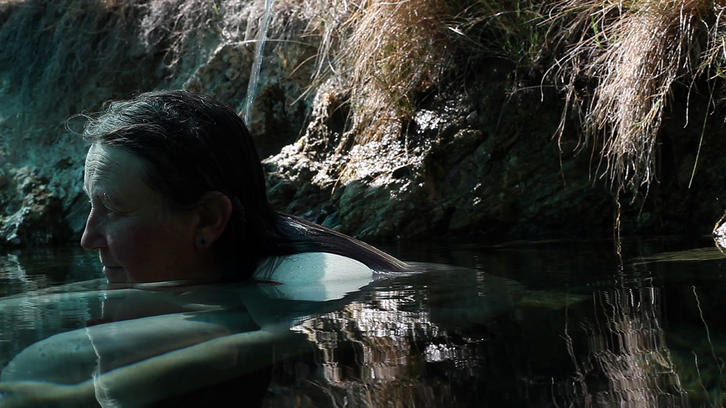
Films about the impact of people on the environment – and vice versa – don’t have to be dry diatribes filled with alarming statistics and images of bubbling pools of pollution. Such is the case with the subtle, observational short documentaries shown during “An Evening With Brigid McCaffrey’’ at the Harvard Film Archive.
In “Castaic Lake’’ (2010), McCaffrey tours the shoreline of the namesake man-made reservoir and California State Recreation Area in northwestern Los Angeles County, observing its semi-artificial environment and speaking with some of those enjoying its pleasures. Elegantly shot and edited, the film subtly integrates human and natural elements of this hybrid resource and recreational attraction.
“Paradise Springs’’ (2010) profiles Ren Lallatin, a recluse/anarchist/geologist who dwells in the Mojave Desert, which here looks like a combination of the lunar surface and Middle-earth. She reflects on the ecological and geological significance of the location, and talks about her own life and her relationship to the human and natural worlds.
Lallatin returns in “Bad Mama, Who Cares’’ (2016), though in a non-speaking role, as McCaffrey moves beyond the merely observational to the nearly hallucinatory. Employing optical effects and a John Cagean soundtrack, McCaffrey’s precise and painterly images range from satellite images of fault-lines to a colorful arrangement of melting Freeze-Pops.
“An Evening With Brigid McCaffery’’ takes place at 7 p.m. on Oct. 17 at the HFA, 24 Quincy St., Cambridge. The filmmaker will be present for a Q&A.
hcl.harvard.edu/hfa/films/2016sepnov/mccaffrey.html
Corps values
To become a professional ballet dancer takes talent, determination, and years of grueling work. For African-Americans aspiring to that goal, the process is even more challenging, as demonstrated in Frances McElroy’s documentary “Black Ballerina.’’
It spans six decades, relating the story of several generations of black women who tried to fulfill their dream but came in conflict with institutional racism. Such pioneers as Joan Myers Brown, Delores Browne, and Raven Wilkinson struggled against this discrimination in pursuing their careers in classical dance. Today young dancers of color don’t have it much easier. McElroy captures the frustrations in her intimate portraits of past and contemporary dancers.
“Black Ballerina’’ can be seen on PBS on Oct 22 at 2 p.m. and 9 p.m.
www.blackballerinadocumentary.org
Casualties of war
Among those on the ground when the atom bomb annihilated Hiroshima on August 6, 1945, were 8-year-old Shigeaki Mori and 12 American airmen held as prisoners of war. Mori survived; the airmen, along with more than 100,000 others, did not.
Their fate remained unknown until years later, when Mori tracked down the identities of these erstwhile airmen – among them Normand Brissette of Lowell — just as he had done for thousands of other victims of the blast. Because of his efforts the Americans’ families gained closure; and the lost airmen’s names were inscribed with those of the other victims of the bomb in the Hiroshima Peace Memorial Museum.
Barry Frechette’s “Paper Lanterns’’ tells the story of Mori’s decades-long mission of compassion and reconciliation. It screens on Oct. 19 at 7 p.m. at the Museum of Fine Arts, 465 Huntington Ave. A Q&A with the director follows.
www.mfa.org/programs/film/paper-lanterns-with-director-barry-frechette
Family reunion
Chances are you haven’t seen Alexandra Anthony’s epic family documentary “Lost in the Bewilderness’’ (2014). Like too many other outstanding independently distributed films, it has not gained the audience and recognition it deserves. In it, Anthony draws on the classic mythology of her Greek origins to relate the odyssey of her cousin, who was taken away from the family by his estranged mother. As intimate as a home movie, yet as universal as the archetypes it evokes, “Lost’’ is the second in a trilogy that began in 1984 with “Yaya’’ and will continue with the work-in-progress “Three Pomegranate Seeds.’’
“Lost in the Bewilderness’’ will screen for free on Oct. 20 at 7 p.m. in the Arlington International Film Festival’s Robbins Library monthly film series, 700 Massachusetts Ave., Arlington. A Q&A with the director follows.
www.lostinthebewilderness.com/screenings
Back to the Philippines
Like “Lost in the Bewilderness,’’ John Gianvito’s 277-minute-long “Wake (Subic)’’ is another underappreciated, independently distributed documentary masterpiece. It’s the second film in a diptych, “For Example, the Philippines, after Vapor Trail (Clark).’’ The diptych began in 2010 with the 264-minute “Vapor Trail (Clark).’’ “Wake (Subic)’’ explores the plight of those who still suffer from the environmental poisoning left behind when the United States abandoned its naval base at Subic Bay, in the Philippines. Using archival photos and period voice recordings and film footage, Gianvito demonstrates how this tragedy is part of a pattern of damage caused by our country’s imperialist aspirations for more than a century. “Wake (Subic)’’ will screen as part of Emerson’s Bright Lights series on Oct. 16 at 2 p.m. at the Bright Family Screening Room, in the Paramount Center, 559 Washington St.. A Q&A with the director follows the screening.
www.emerson.edu/brightlights
Peter Keough can be reached at petervkeough@gmail.com.



